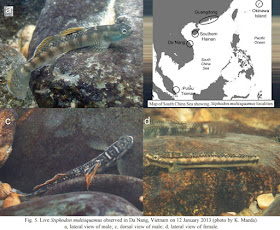 |
| Fig. 5. Live Stiphodon multisquamus observed in Da Nang, Vietnam on 12 January 2013 (photo by K. Maeda). a, b, lateral view of male; c, dorsal view of male; d, lateral view of female Fig. 8. Map of South China Sea showing localities where Stiphodon multisquamus has been recorded.
Maeda et al, 2015. lkcnhm.nus.edu.sg
|
Abstract
Stiphodon multisquamus Wu & Ni, 1986 is a sicydiine goby species previously considered to be endemic to Hainan Island, in southern China. Recently, it was also recorded from the southern Chinese mainland and southern Japan, but it is rare in all of these localities. Available morphological data for S. multisquamus is derived from a small number of specimens and differences between this species and S. aureorostrum Chen & Tan, 2005 from Pulau Tioman, Malaysia are unclear. In the present study, we report on a large population of S. multisquamus from Da Nang, central Vietnam, and described the morphology of this species based on 44 Vietnamese specimens as well as nine additional specimens from Pulau Tioman. Stiphodon multisquamus is distinguished from congeners by the number of soft rays in the second dorsal (usually nine) and pectoral fins (usually 15 or 16), pointed first dorsal fin with elongate spines in males, relatively high tooth counts, predorsal squamation, and a unique colouration, including two or three conspicuous, light-coloured, transverse bars on the occipital region and nape, with fine black spots on the pectoral-fin rays. Stiphodon aureorostrum is considered to represent a junior synonym of S. multisquamus. This is the first record of the subfamily Sicydiinae from Vietnam.
Keywords: Stiphodon multisquamus, Stiphodon aureorostrum, Sicydiinae, continental rivers, freshwater fish, diadromy
Ken Maeda, Hau Duc Tran and Heok Hui Tan. 2015. Discovery of A Substantial Continental Population of the Subfamily Sicydiinae (Gobioidei: Gobiidae) from Vietnam: Taxonomic Revision of the Genus Stiphodon from the western South China Sea. RAFFLES BULLETIN OF ZOOLOGY. 63: 246–258.

